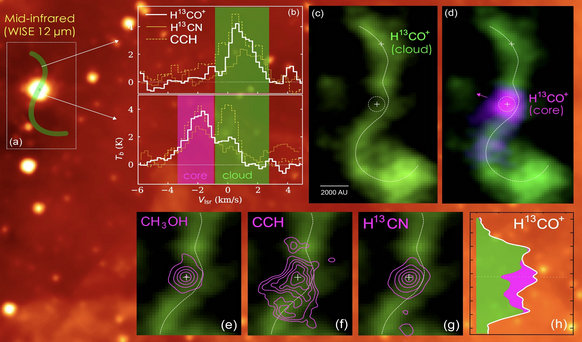Astronomers discovered an infant "escaping star"
Stars are escaping from their birth place and eventually become dispersed over the Galaxy. This is an important process for the Galactic evolution.
Theoretical studies suggest two possible causes for escaping stars. First, the stars could be ejected from interactions in young multiple-stellar systems. Second, they could be accelerated during the collapse or interactions of molecular clouds or clumps.
However, the stars with relatively clear trajectories usually have fully separated from their birth place, while infant protostars are usually deeply embedded in molecular clouds, which makes it difficult to measure their kinematical features. The observational constraints for the escaping stars are therefore still very incomplete.
In contribution to this question, a team of collaborators from Chinese institutes and universities, including the National Astronomical Observatory of the Chinese Academy of Sciences (NAOC), the Shanghai Observatory (SHAO), and Guangzhou University have discovered, for the first time, a protostar leaving its birthplace via high-resolution molecular spectral lines. The result provides new observational evidence for the initial state of escaping stars, and has been recently published in The Astrophysical Journal this October, 2023.
This work used the Atacama Large Millimeter/submillimeter Antenna Array (ALMA) to carry out observations towards a large sample of young star-forming regions. In G352.63-1.07 region, the researchers found a protostellar core (Figure 1a) with noticeably different velocity with its parental molecular cloud, (Figure 1b). The core is observed in a number of molecular lines, which all indicate that the protostar has a different velocity with its parental clouds (Figure 1b to 1f).On the other hand, a number of observed molecular lines closely trace the dense core (Figure 1d to 1f). They thus provide a unique opportunity to measure the stellar motion .
According to the spectral velocity of the molecular lines (Figure 1b), the protostar should have significant blue shift of -2.3 km/s relative to the parent filamentary molecular cloud. At the same time, the core motion has caused a significant dip on the parental molecular cloud (Figure 1h), and is evidently displaced from the major extension of the cloud (dashed line in Figure 1c and to 1g). According to the escaping velocity (-2.3 km/s) and the spatial offset (0.02 light year), The escaping motion should have happened about 4000 years ago, and has a kinetic energy up to 1045 ergs, which makes the core escape in G352.63-1.07asone of the youngest and most energetic event in the star-forming regions in the Milky way.

Figure 1: (a) Mid-infrared image of G352.63-1.07.(b) Molecular lines at the core center and outside, with the shaded areas indicating the two velocity components. (c)-to-(g): molecular line image of the two velocity components. (h) H13CO+ line emission slice for the two components along the major extension of the cloud, with the white line denoting their total intensity. (Credit: NAOC)
In addition, although the escaping velocity of the central star is much lower than the high-speed ejection stars produced in star clusters, it is actually comparable to the average dispersing velocity of the young stars. This suggests that cloud collapse and energy release should be the major mechanism for accelerating the escaping stars.
"Stars are giant nuclear fusion reactors in our universe. The escaping star discovered this time is still in its infancy. This work has snapshotted the initial moment of the stellar escaping motion in nearby active star-forming regions such as Orion Molecular cloud. It enriches the picture of stellar origins and raises a series of challenges," said Prof. LI Di, the chief scientist of the Interstellar Medium Group of NAOC and co-author of this article.
In previous works, based on other observational data, ample scientific results in G352.63-1.07 and nearby regions have been already published, including the first confirmation of the accretion flow from the surrounding environment to the central massive star or the edge of the accretion disk. In subsequent works, researchers will conduct a more in-depth analysis of multi-star interactions and explosive gas expansion in G352.63-1.07.
This work was supported by the Basic Science Center of NSFC, with Dr. REN Zhiyuan, an assistant professor from the Interstellar Medium Evolution and Star Formation Group of NAOC. The article is available at https://iopscience.iop.org/article/10.3847/1538-4357/aced54
Media Contact:
Prof. XU Ang
Email: annxu@nao.cas.cn
Web: http://english.nao.cas.cn